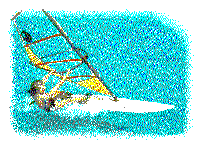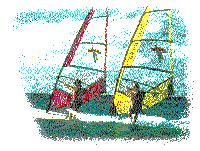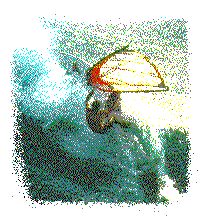
 So
what makes a good learning board. Its the one
that looks really big in the shop as it stretches up
to the roof . But put it on the water and stand on
it and you will love the stable feeling, and the
way it turns so easily in light winds. The rig will
be easy and light to pull out of the water, and wont be too powerfulL That way
you can concentrate on the sailing and figuring out how to turn and go where
you want it to go.
So
what makes a good learning board. Its the one
that looks really big in the shop as it stretches up
to the roof . But put it on the water and stand on
it and you will love the stable feeling, and the
way it turns so easily in light winds. The rig will
be easy and light to pull out of the water, and wont be too powerfulL That way
you can concentrate on the sailing and figuring out how to turn and go where
you want it to go.
 It's important to remember that a
good windsurfer does not necessarily make a good instructor, especially if they
are someone like your boyfriend or an impatint friend. When they want to go
sailing it is windy and that's not the time for you. When it's not windy they they
want to do something else, and the chances are their gear will not be suitable
for learning. . Good instructors make learning an
enjoyable experience. They have the right gear,
they have learning tricks to accelerate your
learning rate, and the gear changes as you
progress. Simulators are a feature of today's
better schools. These teach you where to stand
or you tip off, but no sweat just jump back up.
You can learn how to steer the board and get
your balance before you go out.
It's important to remember that a
good windsurfer does not necessarily make a good instructor, especially if they
are someone like your boyfriend or an impatint friend. When they want to go
sailing it is windy and that's not the time for you. When it's not windy they they
want to do something else, and the chances are their gear will not be suitable
for learning. . Good instructors make learning an
enjoyable experience. They have the right gear,
they have learning tricks to accelerate your
learning rate, and the gear changes as you
progress. Simulators are a feature of today's
better schools. These teach you where to stand
or you tip off, but no sweat just jump back up.
You can learn how to steer the board and get
your balance before you go out.

 The best place to learn to windsurf is where
windsurf schools tend to be. Where there is oHen
sheltered water so the waves are small. Waves
are a real hassle when you are learning. You are
just getting things organised and you lose it
because the waves are making it tricky, so
remember that, and your instructor will help you
notice if the conditions are favourable or not that
day. And that vital ingredient the wind. The wind
perfect for learning is about 4-5 knots (5-6 miles
per hour) and steady rather than gusty (up &
down) . Also when the wind is blowing towards
the shore . . . (onshore) you are likely to blow
back onto the beach and to safety if you don't master the conditions of the day.
The best place to learn to windsurf is where
windsurf schools tend to be. Where there is oHen
sheltered water so the waves are small. Waves
are a real hassle when you are learning. You are
just getting things organised and you lose it
because the waves are making it tricky, so
remember that, and your instructor will help you
notice if the conditions are favourable or not that
day. And that vital ingredient the wind. The wind
perfect for learning is about 4-5 knots (5-6 miles
per hour) and steady rather than gusty (up &
down) . Also when the wind is blowing towards
the shore . . . (onshore) you are likely to blow
back onto the beach and to safety if you don't master the conditions of the day.
 We think it really only takes a
few nours to get the basics sorted out so that you can get going. That is, sailing
in a direction of your choice, and turning around and getting back to where you
started from. By this stage you will also recognise the sort of rig (sail size etc. ),
the kind of board (big and stable with a centreboard) and the beach you are at
the wind conditions of the day are suitable for you or not.
We think it really only takes a
few nours to get the basics sorted out so that you can get going. That is, sailing
in a direction of your choice, and turning around and getting back to where you
started from. By this stage you will also recognise the sort of rig (sail size etc. ),
the kind of board (big and stable with a centreboard) and the beach you are at
the wind conditions of the day are suitable for you or not.

 By
that we mean take at least a four lesson course,
hopefully wth some practice in between and lots
practice afterwards. That way you willl encounter
some varying conditions to test your new found
skills and the lessons you learn have the chance
to be "imprinted". You will then be able to say
with confidence that you can windsurf, although
you will know your limits. Cost $150-$195
depending on the windsurfing school.
By
that we mean take at least a four lesson course,
hopefully wth some practice in between and lots
practice afterwards. That way you willl encounter
some varying conditions to test your new found
skills and the lessons you learn have the chance
to be "imprinted". You will then be able to say
with confidence that you can windsurf, although
you will know your limits. Cost $150-$195
depending on the windsurfing school.
 If you take the fun time to put in
some practice your skills will improve rapidly. You will want to test stronger
and stronger winds. Some prefer to jump in at the deep end but our advice is
not to rush it. There's enjoyment every step of the way to being an expert
windsurfer. In their first season most people stick to their learners board as
they can go surprisingly quickly, although you will find you like to use bigger
sails once you get the knack for getting under way. You will learn the tricks for
whipping the sail out of the water and speeding off if in the blink of an eye. Well
a couple of blinks anyway.
If you take the fun time to put in
some practice your skills will improve rapidly. You will want to test stronger
and stronger winds. Some prefer to jump in at the deep end but our advice is
not to rush it. There's enjoyment every step of the way to being an expert
windsurfer. In their first season most people stick to their learners board as
they can go surprisingly quickly, although you will find you like to use bigger
sails once you get the knack for getting under way. You will learn the tricks for
whipping the sail out of the water and speeding off if in the blink of an eye. Well
a couple of blinks anyway.

 A
few definitions may help a here. A long board is
usually called so if it measures about 3.4 to 3.7
meters in length and may have 200 to 250 litres
of volume or floatation and they have a
centreboard which is a shaped plate which sticks
down like a yacht keel and stops you going
sideways. So they work better in light wind and
so it follows that the best learners boards are
'long" . Short boards tend to be 2.9 m down to
about 2.53 meters in length and these are not so floaty. They need good wind
and experience to operate but when you can, they are fast and manoeuvrable
and so you use these boards to develop your windsurfng into strong wind
sailing.
A
few definitions may help a here. A long board is
usually called so if it measures about 3.4 to 3.7
meters in length and may have 200 to 250 litres
of volume or floatation and they have a
centreboard which is a shaped plate which sticks
down like a yacht keel and stops you going
sideways. So they work better in light wind and
so it follows that the best learners boards are
'long" . Short boards tend to be 2.9 m down to
about 2.53 meters in length and these are not so floaty. They need good wind
and experience to operate but when you can, they are fast and manoeuvrable
and so you use these boards to develop your windsurfng into strong wind
sailing.
 These are kind of short long
boards, or if you like, long short boards. That is they have the manoeuverability
of the short ones and the security and stability of the long ones. You call these
transition boards and they deliver fair weather performance with plenty of
excitement and riders can develop from the learners ranks to well developed
levels on these boards. Hey ... the purists will argue that if you put in enough
time on a long board you can easily switch to the short boards as you can "fly"
wkh your sail and can control your rig higher winds. But others use transition
boards as "fair weather performance" boards as they won't get out too often
and don't really aspire to highspeed thrills. They're into more of a health and
fitness space with their windsurfing.
These are kind of short long
boards, or if you like, long short boards. That is they have the manoeuverability
of the short ones and the security and stability of the long ones. You call these
transition boards and they deliver fair weather performance with plenty of
excitement and riders can develop from the learners ranks to well developed
levels on these boards. Hey ... the purists will argue that if you put in enough
time on a long board you can easily switch to the short boards as you can "fly"
wkh your sail and can control your rig higher winds. But others use transition
boards as "fair weather performance" boards as they won't get out too often
and don't really aspire to highspeed thrills. They're into more of a health and
fitness space with their windsurfing.
But one thing is for sure, time on the water leads to
improvement, and hey, that's where the fun is...
Back to the beach or go back home

 So
what makes a good learning board. Its the one
that looks really big in the shop as it stretches up
to the roof . But put it on the water and stand on
it and you will love the stable feeling, and the
way it turns so easily in light winds. The rig will
be easy and light to pull out of the water, and wont be too powerfulL That way
you can concentrate on the sailing and figuring out how to turn and go where
you want it to go.
So
what makes a good learning board. Its the one
that looks really big in the shop as it stretches up
to the roof . But put it on the water and stand on
it and you will love the stable feeling, and the
way it turns so easily in light winds. The rig will
be easy and light to pull out of the water, and wont be too powerfulL That way
you can concentrate on the sailing and figuring out how to turn and go where
you want it to go. It's important to remember that a
good windsurfer does not necessarily make a good instructor, especially if they
are someone like your boyfriend or an impatint friend. When they want to go
sailing it is windy and that's not the time for you. When it's not windy they they
want to do something else, and the chances are their gear will not be suitable
for learning. . Good instructors make learning an
enjoyable experience. They have the right gear,
they have learning tricks to accelerate your
learning rate, and the gear changes as you
progress. Simulators are a feature of today's
better schools. These teach you where to stand
or you tip off, but no sweat just jump back up.
You can learn how to steer the board and get
your balance before you go out.
It's important to remember that a
good windsurfer does not necessarily make a good instructor, especially if they
are someone like your boyfriend or an impatint friend. When they want to go
sailing it is windy and that's not the time for you. When it's not windy they they
want to do something else, and the chances are their gear will not be suitable
for learning. . Good instructors make learning an
enjoyable experience. They have the right gear,
they have learning tricks to accelerate your
learning rate, and the gear changes as you
progress. Simulators are a feature of today's
better schools. These teach you where to stand
or you tip off, but no sweat just jump back up.
You can learn how to steer the board and get
your balance before you go out.
 The best place to learn to windsurf is where
windsurf schools tend to be. Where there is oHen
sheltered water so the waves are small. Waves
are a real hassle when you are learning. You are
just getting things organised and you lose it
because the waves are making it tricky, so
remember that, and your instructor will help you
notice if the conditions are favourable or not that
day. And that vital ingredient the wind. The wind
perfect for learning is about 4-5 knots (5-6 miles
per hour) and steady rather than gusty (up &
down) . Also when the wind is blowing towards
the shore . . . (onshore) you are likely to blow
back onto the beach and to safety if you don't master the conditions of the day.
The best place to learn to windsurf is where
windsurf schools tend to be. Where there is oHen
sheltered water so the waves are small. Waves
are a real hassle when you are learning. You are
just getting things organised and you lose it
because the waves are making it tricky, so
remember that, and your instructor will help you
notice if the conditions are favourable or not that
day. And that vital ingredient the wind. The wind
perfect for learning is about 4-5 knots (5-6 miles
per hour) and steady rather than gusty (up &
down) . Also when the wind is blowing towards
the shore . . . (onshore) you are likely to blow
back onto the beach and to safety if you don't master the conditions of the day. We think it really only takes a
few nours to get the basics sorted out so that you can get going. That is, sailing
in a direction of your choice, and turning around and getting back to where you
started from. By this stage you will also recognise the sort of rig (sail size etc. ),
the kind of board (big and stable with a centreboard) and the beach you are at
the wind conditions of the day are suitable for you or not.
We think it really only takes a
few nours to get the basics sorted out so that you can get going. That is, sailing
in a direction of your choice, and turning around and getting back to where you
started from. By this stage you will also recognise the sort of rig (sail size etc. ),
the kind of board (big and stable with a centreboard) and the beach you are at
the wind conditions of the day are suitable for you or not.
 By
that we mean take at least a four lesson course,
hopefully wth some practice in between and lots
practice afterwards. That way you willl encounter
some varying conditions to test your new found
skills and the lessons you learn have the chance
to be "imprinted". You will then be able to say
with confidence that you can windsurf, although
you will know your limits. Cost $150-$195
depending on the windsurfing school.
By
that we mean take at least a four lesson course,
hopefully wth some practice in between and lots
practice afterwards. That way you willl encounter
some varying conditions to test your new found
skills and the lessons you learn have the chance
to be "imprinted". You will then be able to say
with confidence that you can windsurf, although
you will know your limits. Cost $150-$195
depending on the windsurfing school. If you take the fun time to put in
some practice your skills will improve rapidly. You will want to test stronger
and stronger winds. Some prefer to jump in at the deep end but our advice is
not to rush it. There's enjoyment every step of the way to being an expert
windsurfer. In their first season most people stick to their learners board as
they can go surprisingly quickly, although you will find you like to use bigger
sails once you get the knack for getting under way. You will learn the tricks for
whipping the sail out of the water and speeding off if in the blink of an eye. Well
a couple of blinks anyway.
If you take the fun time to put in
some practice your skills will improve rapidly. You will want to test stronger
and stronger winds. Some prefer to jump in at the deep end but our advice is
not to rush it. There's enjoyment every step of the way to being an expert
windsurfer. In their first season most people stick to their learners board as
they can go surprisingly quickly, although you will find you like to use bigger
sails once you get the knack for getting under way. You will learn the tricks for
whipping the sail out of the water and speeding off if in the blink of an eye. Well
a couple of blinks anyway.
 A
few definitions may help a here. A long board is
usually called so if it measures about 3.4 to 3.7
meters in length and may have 200 to 250 litres
of volume or floatation and they have a
centreboard which is a shaped plate which sticks
down like a yacht keel and stops you going
sideways. So they work better in light wind and
so it follows that the best learners boards are
'long" . Short boards tend to be 2.9 m down to
about 2.53 meters in length and these are not so floaty. They need good wind
and experience to operate but when you can, they are fast and manoeuvrable
and so you use these boards to develop your windsurfng into strong wind
sailing.
A
few definitions may help a here. A long board is
usually called so if it measures about 3.4 to 3.7
meters in length and may have 200 to 250 litres
of volume or floatation and they have a
centreboard which is a shaped plate which sticks
down like a yacht keel and stops you going
sideways. So they work better in light wind and
so it follows that the best learners boards are
'long" . Short boards tend to be 2.9 m down to
about 2.53 meters in length and these are not so floaty. They need good wind
and experience to operate but when you can, they are fast and manoeuvrable
and so you use these boards to develop your windsurfng into strong wind
sailing. These are kind of short long
boards, or if you like, long short boards. That is they have the manoeuverability
of the short ones and the security and stability of the long ones. You call these
transition boards and they deliver fair weather performance with plenty of
excitement and riders can develop from the learners ranks to well developed
levels on these boards. Hey ... the purists will argue that if you put in enough
time on a long board you can easily switch to the short boards as you can "fly"
wkh your sail and can control your rig higher winds. But others use transition
boards as "fair weather performance" boards as they won't get out too often
and don't really aspire to highspeed thrills. They're into more of a health and
fitness space with their windsurfing.
These are kind of short long
boards, or if you like, long short boards. That is they have the manoeuverability
of the short ones and the security and stability of the long ones. You call these
transition boards and they deliver fair weather performance with plenty of
excitement and riders can develop from the learners ranks to well developed
levels on these boards. Hey ... the purists will argue that if you put in enough
time on a long board you can easily switch to the short boards as you can "fly"
wkh your sail and can control your rig higher winds. But others use transition
boards as "fair weather performance" boards as they won't get out too often
and don't really aspire to highspeed thrills. They're into more of a health and
fitness space with their windsurfing.